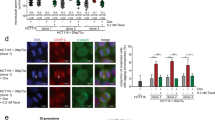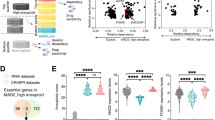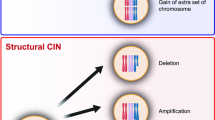Abstract
The p53 tumor suppressor inhibits the proliferation of cells that undergo prolonged activation of the mitotic checkpoint. However, the function of this antiproliferative response is not well defined. Here, we report that p53 suppresses structural chromosome instability after mitotic arrest in human cells. In both HCT116 colon cancer cells and normal human fibroblasts, DNA breaks occurred during mitotic arrest in a p53-independent manner, but p53 was required to suppress the proliferation and structural chromosome instability of the resulting polyploid cells. In contrast, cells made polyploid without mitotic arrest exhibited neither significant structural chromosome instability nor p53-dependent cell cycle arrest. We also observed that p53 suppressed both the frequency and structural chromosome instability of spontaneous polyploids in HCT116 cells. Furthermore, time-lapse videomicroscopy revealed that polyploidization of p53−/− HCT116 cells is frequently accompanied by mitotic arrest. These data suggest that a function of the p53-dependent postmitotic response is the prevention of structural chromosome instability after prolonged activation of the mitotic checkpoint. Accordingly, our study suggests a novel mechanism of tumor suppression for p53, as well as a potential function for p53 in the outcome of antimitotic chemotherapy.
This is a preview of subscription content, access via your institution
Access options
Subscribe to this journal
Receive 50 print issues and online access
$259.00 per year
only $5.18 per issue
Buy this article
- Purchase on Springer Link
- Instant access to full article PDF
Prices may be subject to local taxes which are calculated during checkout







Similar content being viewed by others
References
Andreassen PR, Lohez OD, Lacroix FB, Margolis RL . (2001). Tetraploid state induces p53-dependent arrest of nontransformed mammalian cells in G. Mol Biol Cell 12: 1315–1328.
Artandi SE, Chang S, Lee SL, Alson S, Gottlieb GJ, Chin L et al. (2000). Telomere dysfunction promotes non-reciprocal translocations and epithelial cancers in mice. Nature 406: 641–645.
Aylon Y, Michael D, Shmueli A, Yabuta N, Nojima H, Oren M . (2006). A positive feedback loop between the p53 and Lats2 tumor suppressors prevents tetraploidization. Genes Dev 20: 2687–2700.
Bassing CH, Suh H, Ferguson DO, Chua KF, Manis J, Eckersdorff M et al. (2003). Histone H2AX: a dosage-dependent suppressor of oncogenic translocations and tumors. Cell 114: 359–370.
Bischoff FZ, Yim SO, Pathak S, Grant G, Siciliano MJ, Giovanella BC et al. (1990). Spontaneous abnormalities in normal fibroblasts from patients with Li-Fraumeni cancer syndrome: aneuploidy and immortalization. Cancer Res 50: 7979–7984.
Blagosklonny MV . (2006). Prolonged mitosis versus tetraploid checkpoint: how p53 measures the duration of mitosis. Cell Cycle 5: 971–975.
Bouffler SD, Kemp CJ, Balmain A, Cox R . (1995). Spontaneous and ionizing radiation-induced chromosomal abnormalities in p53-deficient mice. Cancer Res 55: 3883–3889.
Bunz F, Dutriaux A, Lengauer C, Waldman T, Zhou S, Brown JP et al. (1998). Requirement for p53 and p21 to sustain G2 arrest after DNA damage. Science 282: 1497–1501.
Bunz F, Fauth C, Speicher MR, Dutriaux A, Sedivy JM, Kinzler KW et al. (2002). Targeted inactivation of p53 in human cells does not result in aneuploidy. Cancer Res 62: 1129–1133.
Bunz F, Hwang PM, Torrance C, Waldman T, Zhang Y, Dillehay L et al. (1999). Disruption of p53 in human cancer cells alters the responses to therapeutic agents. J Clin Invest 104: 263–269.
Castedo M, Coquelle A, Vivet S, Vitale I, Kauffmann A, Dessen P et al. (2006). Apoptosis regulation in tetraploid cancer cells. EMBO J 25: 2584–2595.
Chan YW, On KF, Chan WM, Wong W, Siu HO, Hau PM et al. (2008). The kinetics of p53 activation versus cyclin E accumulation underlies the relationship between the spindle-assembly checkpoint and the postmitotic checkpoint. J Biol Chem 283: 15716–15723.
Cross SM, Sanchez CA, Morgan CA, Schimke MK, Ramel S, Idzerda RL et al. (1995). A p53-dependent mouse spindle checkpoint. Science 267: 1353–1356.
Curtis LJ, Georgiades IB, White S, Bird CC, Harrison DJ, Wyllie AH . (2000). Specific patterns of chromosomal abnormalities are associated with RER status in sporadic colorectal cancer. J Pathol 192: 440–445.
Dalton WB, Nandan MO, Moore RT, Yang VW . (2007). Human cancer cells commonly acquire DNA damage during mitotic arrest. Cancer Res 67: 11487–11492.
Dalton WB, Yang VW . (2009). The role of prolonged mitotic checkpoint activation in the formation and treatment of cancer. Future Oncol 5: 1363–1370.
De Angelis PM, Clausen OP, Schjolberg A, Stokke T . (1999). Chromosomal gains and losses in primary colorectal carcinomas detected by CGH and their associations with tumour DNA ploidy, genotypes and phenotypes. Br J Cancer 80: 526–535.
Di Leonardo A, Khan SH, Linke SP, Greco V, Seidita G, Wahl GM . (1997). DNA rereplication in the presence of mitotic spindle inhibitors in human and mouse fibroblasts lacking either p53 or pRb function. Cancer Res 57: 1013–1019.
Eshleman JR, Casey G, Kochera ME, Sedwick WD, Swinler SE, Veigl ML et al. (1998). Chromosome number and structure both are markedly stable in RER colorectal cancers and are not destabilized by mutation of p53. Oncogene 17: 719–725.
Fujiwara T, Bandi M, Nitta M, Ivanova EV, Bronson RT, Pellman D . (2005). Cytokinesis failure generating tetraploids promotes tumorigenesis in p53-null cells. Nature 437: 1043–1047.
Galmarini CM, Falette N, Tabone E, Levrat C, Britten R, Voorzanger-Rousselot N et al. (2001). Inactivation of wild-type p53 by a dominant negative mutant renders MCF-7 cells resistant to tubulin-binding agent cytotoxicity. Br J Cancer 85: 902–908.
Ganem NJ, Pellman D . (2007). Limiting the proliferation of polyploid cells. Cell 131: 437–440.
Ganem NJ, Storchova Z, Pellman D . (2007). Tetraploidy, aneuploidy and cancer. Curr Opin Genet Dev 17: 157–162.
Hastak K, Paul RK, Agarwal MK, Thakur VS, Amin AR, Agrawal S et al. (2008). DNA synthesis from unbalanced nucleotide pools causes limited DNA damage that triggers ATR-CHK1-dependent p53 activation. Proc Natl Acad Sci USA 105: 6314–6319.
Hernando E, Nahle Z, Juan G, Diaz-Rodriguez E, Alaminos M, Hemann M et al. (2004). Rb inactivation promotes genomic instability by uncoupling cell cycle progression from mitotic control. Nature 430: 797–802.
Ikeuchi T, Weinfeld H, Sandberg AA . (1972). Chromosome pulverization in micronuclei induced by tritiated thymidine. J Cell Biol 52: 97–104.
Jong YJ, Li LH, Tsou MH, Chen YJ, Cheng SH, Wang-Wuu S et al. (2004). Chromosomal comparative genomic hybridization abnormalities in early- and late-onset human breast cancers: correlation with disease progression and TP53 mutations. Cancer Genet Cytogenet 148: 55–65.
Kato H, Sandberg AA . (1967). Chromosome pulverization in human binucleate cells following colcemid treatment. J Cell Biol 34: 35–45.
Kienitz A, Vogel C, Morales I, Muller R, Bastians H . (2005). Partial downregulation of MAD1 causes spindle checkpoint inactivation and aneuploidy, but does not confer resistance towards taxol. Oncogene 24: 4301–4310.
Kim KT, Ongusaha PP, Hong YK, Kurdistani SK, Nakamura M, Lu KP et al. (2004). Function of Drg1/Rit42 in p53-dependent mitotic spindle checkpoint. J Biol Chem 279: 38597–38602.
Kleivi K, Diep CB, Pandis N, Heim S, Teixeira MR, Lothe RA . (2005). TP53 mutations are associated with a particular pattern of genomic imbalances in breast carcinomas. J Pathol 207: 14–19.
Koller E, Propp S, Zhang H, Zhao C, Xiao X, Chang M et al. (2006). Use of a chemically modified antisense oligonucleotide library to identify and validate Eg5 (kinesin-like 1) as a target for antineoplastic drug development. Cancer Res 66: 2059–2066.
Lalle P, Moyret-Lalle C, Wang Q, Vialle JM, Navarro C, Bressac-de Paillerets B et al. (1995). Genomic stability and wild-type p53 function of lymphoblastoid cells with germ-line p53 mutation. Oncogene 10: 2447–2454.
Lanni JS, Jacks T . (1998). Characterization of the p53-dependent postmitotic checkpoint following spindle disruption. Mol Cell Biol 18: 1055–1064.
Linke SP, Clarkin KC, Di Leonardo A, Tsou A, Wahl GM . (1996). A reversible, p53-dependent G0/G1 cell cycle arrest induced by ribonucleotide depletion in the absence of detectable DNA damage. Genes Dev 10: 934–947.
Lu C, El-Deiry WS . (2009). Targeting p53 for enhanced radio- and chemo-sensitivity. Apoptosis 14: 597–606.
Matoba S, Kang JG, Patino WD, Wragg A, Boehm M, Gavrilova O et al. (2006). p53 regulates mitochondrial respiration. Science 312: 1650–1653.
Minn AJ, Boise LH, Thompson CB . (1996). Expression of Bcl-xL and loss of p53 can cooperate to overcome a cell cycle checkpoint induced by mitotic spindle damage. Genes Dev 10: 2621–2631.
Muller M, Schleithoff ES, Stremmel W, Melino G, Krammer PH, Schilling T . (2006). One, two, three--p53, p63, p73 and chemosensitivity. Drug Resist Updat 9: 288–306.
Pantic M, Zimmermann S, Daly E, Opitz OG, Popp S, Boukamp P et al. (2006). Telomere dysfunction and loss of p53 cooperate in defective mitotic segregation of chromosomes in cancer cells. Oncogene 25: 4413–4420.
Pfleghaar K, Heubes S, Cox J, Stemmann O, Speicher MR . (2005). Securin is not required for chromosomal stability in human cells. PLoS Biol 3: e416.
Quignon F, Rozier L, Lachages AM, Bieth A, Simili M, Debatisse M . (2007). Sustained mitotic block elicits DNA breaks: one-step alteration of ploidy and chromosome integrity in mammalian cells. Oncogene 26: 165–172.
Rajagopalan H, Jallepalli PV, Rago C, Velculescu VE, Kinzler KW, Vogelstein B et al. (2004). Inactivation of hCDC4 can cause chromosomal instability. Nature 428: 77–81.
Rieder CL, Maiato H . (2004). Stuck in division or passing through: what happens when cells cannot satisfy the spindle assembly checkpoint. Dev Cell 7: 637–651.
Rogakou EP, Boon C, Redon C, Bonner WM . (1999). Megabase chromatin domains involved in DNA double-strand breaks in vivo. J Cell Biol 146: 905–916.
Rogakou EP, Pilch DR, Orr AH, Ivanova VS, Bonner WM . (1998). DNA double-stranded breaks induce histone H2AX phosphorylation on serine 139. J Biol Chem 273: 5858–5868.
Savage JR . (1976). Classification and relationships of induced chromosomal structual changes. J Med Genet 13: 103–122.
Shi J, Orth JD, Mitchison T . (2008). Cell type variation in responses to antimitotic drugs that target microtubules and kinesin-5. Cancer Res 68: 3269–3276.
Song H, Hollstein M, Xu Y . (2007). p53 gain-of-function cancer mutants induce genetic instability by inactivating ATM. Nat Cell Biol 9: 573–580.
Sotillo R, Hernando E, Diaz-Rodriguez E, Teruya-Feldstein J, Cordon-Cardo C, Lowe SW et al. (2007). Mad2 overexpression promotes aneuploidy and tumorigenesis in mice. Cancer Cell 11: 9–23.
Stevens JB, Liu G, Bremer SW, Ye KJ, Xu W, Xu J et al. (2007). Mitotic cell death by chromosome fragmentation. Cancer Res 67: 7686–7694.
Stewenius Y, Gorunova L, Jonson T, Larsson N, Hoglund M, Mandahl N et al. (2005). Structural and numerical chromosome changes in colon cancer develop through telomere-mediated anaphase bridges, not through mitotic multipolarity. Proc Natl Acad Sci USA 102: 5541–5546.
Stukenberg PT . (2004). Triggering p53 after cytokinesis failure. J Cell Biol 165: 607–608.
Swanton C, Nicke B, Schuett M, Eklund AC, Ng C, Li Q et al. (2009). Chromosomal instability determines taxane response. Proc Natl Acad Sci USA 106: 8671–8676.
Tao W, South VJ, Diehl RE, Davide JP, Sepp-Lorenzino L, Fraley ME et al. (2007). An inhibitor of the kinesin spindle protein activates the intrinsic apoptotic pathway independently of p53 and de novo protein synthesis. Mol Cell Biol 27: 689–698.
Thibodeau A, Vincent M . (1991). Monoclonal antibody CC-3 recognizes phosphoproteins in interphase and mitotic cells. Exp Cell Res 195: 145–153.
Thompson SL, Compton DA . (2008). Examining the link between chromosomal instability and aneuploidy in human cells. J Cell Biol 180: 665–672.
Tighe A, Johnson VL, Taylor SS . (2004). Truncating APC mutations have dominant effects on proliferation, spindle checkpoint control, survival and chromosome stability. J Cell Sci 117: 6339–6353.
Toledo F, Wahl GM . (2006). Regulating the p53 pathway: in vitro hypotheses, in vivo veritas. Nat Rev Cancer 6: 909–923.
Uetake Y, Sluder G . (2004). Cell cycle progression after cleavage failure: mammalian somatic cells do not possess a ‘tetraploidy checkpoint’. J Cell Biol 165: 609–615.
Uetake Y, Sluder G . (2007). Cell-cycle progression without an intact microtuble cytoskeleton. Curr Biol 17: 2081–2086.
van Gent DC, Hoeijmakers JH, Kanaar R . (2001). Chromosomal stability and the DNA double-stranded break connection. Nat Rev Genet 2: 196–206.
Vogel C, Kienitz A, Hofmann I, Muller R, Bastians H . (2004). Crosstalk of the mitotic spindle assembly checkpoint with p53 to prevent polyploidy. Oncogene 23: 6845–6853.
Vousden KH, Lane DP . (2007). p53 in health and disease. Nat Rev Mol Cell Biol 8: 275–283.
Vousden KH, Lu X . (2002). Live or let die: the cell's response to p53. Nat Rev Cancer 2: 594–604.
Wahl AF, Donaldson KL, Fairchild C, Lee FY, Foster SA, Demers GW et al. (1996). Loss of normal p53 function confers sensitization to Taxol by increasing G2/M arrest and apoptosis. Nat Med 2: 72–79.
Ward IM, Difilippantonio S, Minn K, Mueller MD, Molina JR, Yu X et al. (2005). 53BP1 cooperates with p53 and functions as a haploinsufficient tumor suppressor in mice. Mol Cell Biol 25: 10079–10086.
Weaver BA, Silk AD, Montagna C, Verdier-Pinard P, Cleveland DW . (2007). Aneuploidy acts both oncogenically and as a tumor suppressor. Cancer Cell 11: 25–36.
Westra JL, Boven LG, van der Vlies P, Faber H, Sikkema B, Schaapveld M et al. (2005). A substantial proportion of microsatellite-unstable colon tumors carry TP53 mutations while not showing chromosomal instability. Genes Chromosomes Cancer 43: 194–201.
Wong C, Stearns T . (2005). Mammalian cells lack checkpoints for tetraploidy, aberrant centrosome number, and cytokinesis failure. BMC Cell Biol 6: 6.
Woods CM, Zhu J, McQueney PA, Bollag D, Lazarides E . (1995). Taxol-induced mitotic block triggers rapid onset of a p53-independent apoptotic pathway. Mol Med 1: 506–526.
Yamaguchi H, Chen J, Bhalla K, Wang HG . (2004). Regulation of Bax activation and apoptotic response to microtubule-damaging agents by p53 transcription-dependent and -independent pathways. J Biol Chem 279: 39431–39437.
Yang Z, Loncarek J, Khodjakov A, Rieder CL . (2008). Extra centrosomes and/or chromosomes prolong mitosis in human cells. Nat Cell Biol 10: 748–751.
Yoon HS, Ghaleb AM, Nandan MO, Hisamuddin IM, Dalton WB, Yang VW . (2005). Kruppel-like factor 4 prevents centrosome amplification following gamma-irradiation-induced DNA damage. Oncogene 24: 4017–4025.
Zhang H, Shi X, Zhang QJ, Hampong M, Paddon H, Wahyuningsih D et al. (2002). Nocodazole-induced p53-dependent c-Jun N-terminal kinase activation reduces apoptosis in human colon carcinoma HCT116 cells. J Biol Chem 277: 43648–43658.
Zhuanzi W, Wenjian L, Dejuan Z, Wei W, Xigang J, Qingxiang G . (2007). Chromatid-type aberrations following irradiation in G0 lymphocytes with heavy ions. Mutat Res 617: 98–103.
Acknowledgements
We thank D Pallas, P Doetsch, D Jones, A Corbett, G Davis, and M Wiltenburg for discussion and support, and B Vogelstein for providing cell lines. This work was supported in part by grants from the National Institutes of Health to VWY (DK52230, DK64399, and CA84197) and to WBD (5T32GM008367-18). This work was supported in part by grants from the National Institutes of Health to VWY (DK52230, DK64399, and CA84197) and to WBD (5T32GM008367).
Author information
Authors and Affiliations
Corresponding author
Additional information
Supplementary Information accompanies the paper on the Oncogene website (http://www.nature.com/onc)
Supplementary information
Rights and permissions
About this article
Cite this article
Dalton, W., Yu, B. & Yang, V. p53 suppresses structural chromosome instability after mitotic arrest in human cells. Oncogene 29, 1929–1940 (2010). https://doi.org/10.1038/onc.2009.477
Received:
Revised:
Accepted:
Published:
Issue Date:
DOI: https://doi.org/10.1038/onc.2009.477
Keywords
This article is cited by
-
Permission to pass: on the role of p53 as a gatekeeper for aneuploidy
Chromosome Research (2023)
-
hCINAP regulates the DNA-damage response and mediates the resistance of acute myelocytic leukemia cells to therapy
Nature Communications (2019)
-
The responses of cancer cells to PLK1 inhibitors reveal a novel protective role for p53 in maintaining centrosome separation
Scientific Reports (2017)
-
An association between nuclear morphology and immunohistochemical expression of p53 and p16INK4A in lung cancer cells
Medical Molecular Morphology (2014)
-
Krüppel-like factor 4 regulates genetic stability in mouse embryonic fibroblasts
Molecular Cancer (2013)



